Lab Flooring Questions
Before investing in new flooring for your lab, there are a number of questions for you to consider in the areas of:
Operations, Aesthetics, Installation, and Maintenance.
Operations
You don’t want anybody to slip in your lab, so obviously you want to select a tile with slip resistance. The question is how much. Some environments may need greater slip resistance. If your facility requires a greater level of slip resistance, then you will want to steer clear of slick materials like epoxies. Seek out products that provide more secure footing. Tiles that utilize a coin-top texture offer better slip resistance.
Some floorings are better for humans to stand on for long periods of time than others. For example, epoxies are hard. Same holds true with glued-down vinyl flooring. Typically, the more ergonomic and comfortable the floor, the higher the cost. There are many benefits to taking on the extra expense. Lab or cleanroom workers who are more comfortable will be more productive and miss less time due to standing-related injuries, like plantar fasciitis. Less injuries and more comfortable work conditions also improve staff retention.
Some floors are better for cleanrooms and labs than others. For example, epoxies and vinyls. Cleanrooms and labs will have their own standards to adhere to and that’s something the flooring dealer should review with customers. For example, some products generate particulates when you scrub. This requires a sealant to be applied to prevent that from happening. Again, this should be part of a review with the flooring company to ensure the flooring meets your requirements.
As a lab or cleanroom, it’s possible your facility might employ chemicals that may impact the material used on the flooring you select. Having a detailed conversation about your operation is critical to making a wise selection. If there are chemicals in your work environment, there are some possible solutions. For example, resistance to certain chemicals, such as solvents or acids. Vinyl is resistant to many chemicals and is generally a good choice. Rubber is good for other chemicals, like chlorinated solvents. If possible, get a sample of the flooring that you are considering and test it against the chemicals that you have in your lab.
Aesthetics
The topic of aesthetics comes up more than you might think. We have a broad product line, including a variety of colors and price points. For some labs and cleanrooms with more electronics, the combination of color and ESD properties has made our FreeStyle ESD product very popular. And while most companies seek our products for their physical properties and how our tiles protect the integrity of the lab or cleanroom, the subject of color comes up quite a bit, particularly if you are working with an architect.
Installation
If beneath your existing flooring there is concrete, moisture could be an issue and will need to be checked first. Particularly, if the flooring you’re considering needs to be glued. In that scenario, it’s also not advisable to glue the new floor onto the old floor. It should be installed onto the underlying concrete. If you are planning on using interlock flooring, first test the old flooring for asbestos. Removing flooring with asbestos is a very detailed process. Areas of the floor need to be sectioned off with plastic as air pressure is used to contain any dust.
Both the flooring and the adhesive of your old flooring should be tested for asbestos prior to gluing down new flooring or before installing interlocking flooring. Dealing with asbestos is costly and will delay installation. Interlocking tiles can be installed on top of old asbestos-containing floor without having to remove it.
When you rip out the old flooring, it will generate some level of dust. Will that have an impact on your equipment and electronics at your facility? That must be considered and assessed. It could have an impact on your decision to go with a glue-down flooring or interlock.
Maintenance
In a lab or cleanroom, it kind of goes without saying that frequent cleaning is necessary. Still, frequency in cleaning is a consideration with what kind of tile you select. Part of that decision is how important the look of the title is to your organization. Some of our products, the FreeStyle ESDPlus for example, stays cleaner longer. If you have a very dirty environment, we recommend that tile. Since most if not all labs or cleanrooms receive regular or daily cleaning, then you have some flexibility on choice.
One thing to keep in mind is that many times the more expensive tile is less expensive to maintain. So, you could select a less expensive tile, but it will require more in maintenance (e.g. additional janitorial services; more expensive floor maintenance equipment). Over time, the more expensive tile will probably offer better value and cost less than the less expensive tile. This is something we typically review with customers in discussing the budget for flooring.
Other considerations
If you would like more information about our tiles as a possible solution for your laboratory or cleanroom, drop us a line or give us a call at 508-583-3200.





